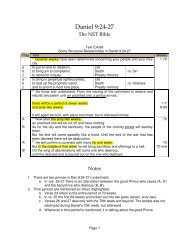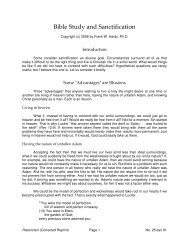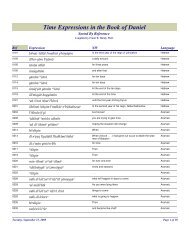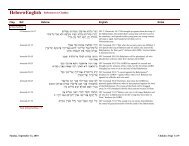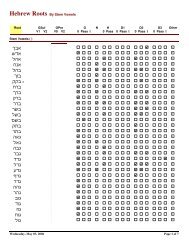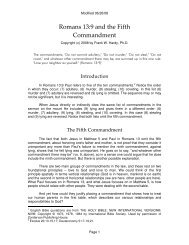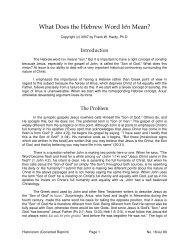Hardy<strong>Timeline</strong>A fact I cannot account for without changing Hoshea's method <strong>of</strong> reckoning also is that ifHoshea used <strong>the</strong> accession year while Jotham did not, Hoshea would not have agreed withJotham on what <strong>the</strong> twentieth year <strong>of</strong> his reign was. As <strong>the</strong> timeline is drawn, <strong>the</strong>y do agree. Ifdifferent systems were in use we would expect Hoshea to refer to <strong>the</strong> nineteenth year <strong>of</strong> Jothamin 2 Kgs 15:30 ra<strong>the</strong>r than <strong>the</strong> twentieth. The synchronism is that <strong>of</strong> a single system, butbecause Jotham refers elsewhere to <strong>the</strong> summer months <strong>of</strong> 739 as <strong>the</strong> second year <strong>of</strong> Pekahra<strong>the</strong>r than <strong>the</strong> first in 2 Kgs 15:32 we can be sure that Jotham was indeed using a differentsystem <strong>of</strong> reckoning from Pekah. One unresolved problem <strong>the</strong>refore is why Jotham aloneshould ab<strong>and</strong>on <strong>the</strong> accession year <strong>and</strong> ano<strong>the</strong>r is why Hoshea should agree with Jotham as to<strong>the</strong> identity <strong>of</strong> his twentieth year.2 Kgs 17:1 <strong>and</strong> <strong>the</strong> reign <strong>of</strong> AhazThe reason for <strong>the</strong> unusual relationships among <strong>the</strong> reigns <strong>of</strong> Azariah, Jotham, <strong>and</strong>Ahaz, according to 2 Kgs 17:1 <strong>and</strong> o<strong>the</strong>r passages, appears to have had its origin in Azariah'slack <strong>of</strong> physical well-being during <strong>the</strong> last years <strong>of</strong> his life.The Lord afflicted <strong>the</strong> king [Azariah] with leprosy until <strong>the</strong> day he died, <strong>and</strong> he lived in a separatehouse. Jotham <strong>the</strong> king's son had charge <strong>of</strong> <strong>the</strong> palace <strong>and</strong> governed <strong>the</strong> people <strong>of</strong> <strong>the</strong> l<strong>and</strong>. (2Kgs 15:5)Although Azariah was still alive during <strong>the</strong> years 750-739, <strong>and</strong> although those years arecounted as part <strong>of</strong> his fifty-two years <strong>of</strong> rule in 2 Kgs 15:2, after he contracted leprosy he did nottake part in public affairs. For all intents <strong>and</strong> purposes Jotham was <strong>the</strong> only king. As such hefelt it expedient to have a coregent <strong>of</strong> his own on <strong>the</strong> throne with him to help share <strong>the</strong>responsibilities <strong>of</strong> state <strong>and</strong> to protect <strong>the</strong> succession in <strong>the</strong> event that his death should come inan unexpected manner.When Azariah finally died in 739, after an unusually long reign, Jotham was made king inname as well as fact <strong>and</strong> Ahaz continued his earlier role as junior partner on <strong>the</strong> throne. In735/34, after ruling sixteen years from <strong>the</strong> time <strong>of</strong> his coregency with Azariah, Jothamapparently followed his fa<strong>the</strong>r's example for reasons we do not underst<strong>and</strong> <strong>and</strong> retired frompublic life (2 Kgs 15:33), leaving Ahaz fully in charge <strong>of</strong> <strong>the</strong> affairs <strong>of</strong> state (2 Kgs 16:1). Weknow, however, that Jotham did not die until 732/31 (2 Kgs 15:30). At that point <strong>the</strong> <strong>of</strong>ficial solerule <strong>of</strong> Ahaz began (2 Kgs 16:2). Ahaz himself died in 716/15, having associated Hezekiah withhim on <strong>the</strong> throne some years previously in 729/28 (2 Kgs 18:1).The above is consistent with all <strong>of</strong> <strong>the</strong> biblical data. Not one verse is left over or needs tobe set aside as untrustworthy. Fur<strong>the</strong>rmore <strong>the</strong> course <strong>of</strong> events described, though unusual, asstated above, is not unreasonable. By dating <strong>the</strong> coregency <strong>of</strong> Ahaz to 744/43 instead <strong>of</strong>732/31 Kitchen <strong>and</strong> Mitchell have, in my view, solved <strong>the</strong> problem <strong>of</strong> 2 Kgs 17:1 <strong>and</strong> have doneso in a straightforward <strong>and</strong> convincing manner.Manner <strong>of</strong> PresentationThere are twenty-eight synchronisms between <strong>the</strong> kings <strong>of</strong> <strong>Israel</strong> <strong>and</strong> <strong>Judah</strong> in 1-2<strong>Kings</strong>. In part II <strong>of</strong> his series <strong>of</strong> papers entitled, "The Synchronisms <strong>of</strong> <strong>the</strong> Hebrew <strong>Kings</strong> - ARe-Evaluation," Thiele lists thirty-three passages that bear on <strong>the</strong> discussion, 21 <strong>of</strong> which only<strong>Historicism</strong> (Corrected) Page 8 <strong>Timeline</strong>
Hardy<strong>Timeline</strong>twenty-eight contain synchronisms, 22 as he makes clear. In part III <strong>of</strong> <strong>the</strong> present monograph Inumber <strong>the</strong> twenty-eight synchronisms consecutively, ra<strong>the</strong>r than using <strong>the</strong>ir original numbersas given in Thiele's table.The timeline for <strong>Israel</strong> appears first on each page--during <strong>the</strong> period when <strong>the</strong>re is akingdom <strong>of</strong> <strong>Israel</strong>--<strong>and</strong> is followed by that for <strong>Judah</strong>. The nor<strong>the</strong>rn kingdom <strong>of</strong> <strong>Israel</strong> uses aspring-to-spring calendar that begins during March or April (Nisan 1); <strong>the</strong> sou<strong>the</strong>rn kingdom <strong>of</strong><strong>Judah</strong> uses a fall-to-fall calendar that begins during September or October (Tishri 1). 23 Thespring or fall beginning point for <strong>the</strong> semitic year in ei<strong>the</strong>r case is indicated by a period, while <strong>the</strong>winter beginning point for <strong>the</strong> Julian year, used as a point <strong>of</strong> reference for <strong>the</strong> convenience <strong>of</strong><strong>the</strong> modern reader (January 1), is indicated by a vertical stroke. Sample line segments for bothspring-to-spring <strong>and</strong> fall-to-fall calendars are shown below. 24 See fig. 1.<strong>Israel</strong>/SS|. |. |. |. |. |. |. |. |. |. |. |<strong>Judah</strong>/FF| . | . | . | . | . | . | . | . | . | . | . |Fig. 1. Sample timeline segment showing contrast between <strong>the</strong> spring-to-spring calendarused in <strong>Israel</strong> <strong>and</strong> <strong>the</strong> fall-to-fall calendar used in <strong>Judah</strong>.Throughout part III <strong>of</strong> <strong>the</strong> present supplement Julian year numbers appear immediatelyabove <strong>the</strong> timeline <strong>and</strong> <strong>the</strong> regnal years <strong>of</strong> whatever king is in power appear immediately below<strong>the</strong> timeline. As nearly as possible <strong>the</strong> name <strong>of</strong> a given king, with his total years <strong>of</strong> rule inparen<strong>the</strong>ses, <strong>and</strong> <strong>the</strong> appropriate reference to 1 or 2 <strong>Kings</strong>, appear in a bloc directly over <strong>the</strong>point where his reign begins. When a king comes to power before his fa<strong>the</strong>r's death, <strong>the</strong>coregent's reign could be said to begin with his period <strong>of</strong> joint rule or with his period <strong>of</strong> solerule. 25 In such cases <strong>the</strong> name, length <strong>of</strong> reign, <strong>and</strong> reference are placed with <strong>the</strong> synchronism,except for Azariah <strong>and</strong> Jotham <strong>of</strong> <strong>Judah</strong> <strong>and</strong> Jeroboam II <strong>of</strong> <strong>Israel</strong> where <strong>the</strong> total length <strong>of</strong> reignincludes <strong>the</strong>se kings' coregencies.Fur<strong>the</strong>r in regard to coregencies, whenever a king begins his reign with a coregency Ishow how that king's regnal years would be counted from ei<strong>the</strong>r starting point. Both rows <strong>of</strong>numbers are labelled appropriately <strong>and</strong> <strong>the</strong> label appears below <strong>the</strong> line to which it refers.Taking one example, <strong>the</strong> first coregency in <strong>Judah</strong> involves an overlap between Asa(911/10-871/70) <strong>and</strong> Jehoshaphat (872-848). 26 Because each page represents twenty years,<strong>and</strong> because Jehoshaphat ruled twenty-five years, his reign extends to more than one page. At<strong>the</strong> point where it is continued after <strong>the</strong> page break his regnal years are labeled as follows. Seefig. 2.13 14 15 16 17 18 19 20 21 22 23 24 25(Jehoshaphat, coregency)10 11 12 13 14 15 16 17 18 19 20 21 22(Jehoshaphat, sole rule)Fig. 2. Sample timeline segment showing how <strong>the</strong> years <strong>of</strong> a king's reign are labeledwhen numbered both from his coregency <strong>and</strong> from his period <strong>of</strong> sole rule.<strong>Historicism</strong> (Corrected) Page 9 <strong>Timeline</strong>



